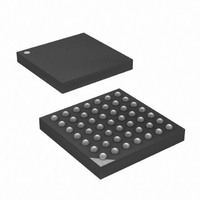ATXMEGA16A4-CUR Atmel, ATXMEGA16A4-CUR Datasheet - Page 364

ATXMEGA16A4-CUR
Manufacturer Part Number
ATXMEGA16A4-CUR
Description
MCU AVR 16+4KB FLASH 49VFBGA
Manufacturer
Atmel
Series
AVR® XMEGAr
Specifications of ATXMEGA16A4-CUR
Core Processor
AVR
Core Size
8/16-Bit
Speed
32MHz
Connectivity
I²C, IrDA, SPI, UART/USART
Peripherals
Brown-out Detect/Reset, DMA, POR, PWM, WDT
Number Of I /o
34
Program Memory Size
16KB (8K x 16)
Program Memory Type
FLASH
Eeprom Size
1K x 8
Ram Size
2K x 8
Voltage - Supply (vcc/vdd)
1.6 V ~ 3.6 V
Data Converters
A/D 12x12b, D/A 2x12b
Oscillator Type
Internal
Operating Temperature
-40°C ~ 85°C
Package / Case
49-VFBGA
For Use With
ATAVRONEKIT - KIT AVR/AVR32 DEBUGGER/PROGRMMRATSTK600 - DEV KIT FOR AVR/AVR32770-1007 - ISP 4PORT ATMEL AVR MCU SPI/JTAG770-1004 - ISP 4PORT FOR ATMEL AVR MCU SPI
Lead Free Status / RoHS Status
Lead free / RoHS Compliant
Available stocks
Company
Part Number
Manufacturer
Quantity
Price
- Current page: 364 of 445
- Download datasheet (6Mb)
30.6
30.6.1
30.6.2
8077H–AVR–12/09
Flash and EEPROM Page Buffers
Flash Page Buffer
EEPROM Page Buffer
This ensures that the given command is executed and the operation finished before a new can
start. The External programmer or application software must ensure that the NVM is not
addressed while busy with a programming operation.
Programming any part of the NVM will automatically block:
During Self-Programming interrupts must be disabled, or the Interrupt Vector table should be
moved to the Boot Loader Sections as described in
Interrupt Controller” on page
The Flash memory is updated in a page-by-page fashion. The EEPROM can be updated both in
a byte-by-byte and page-by-page fashion. Flash and EEPROM page programming is done by
first filling the associated page buffer, and then writing the entire page buffer to a selected page
in Flash or EEPROM. For both Flash and EEPROM, page erase and write each requires 4 ms.
The size of the page buffers depend on the Flash and EEPROM size in each device, and details
on page size and page number is described in each device data sheet.
The Flash page buffer is filled one word at a time, and it must be erased before it can be loaded.
If an already loaded location is written again, this will corrupt the content of that Flash page buf-
fer location.
Flash page buffer Locations that are not loaded will have the value 0xFFFF, and this value will
then be programmed into the flash page locations.
The Flash Page Buffer is automatically erased after:
The EEPROM page buffer is filled one byte at a time and it must be erased before it can be
loaded. If an already loaded location is written twice, this will corrupt the content of that
EEPROM page buffer location.
EEPROM page buffer locations that are loaded will get tagged by the NVM Controller. During a
page write or page erase, only target locations will be written or erased. Locations that are not
target, will not be written or erased, and the corresponding EEPROM location will remain
unchanged. This means that also before an EEPROM page erase, data must be loaded to the
selected page buffer location to tag them. If the data in the page buffer is not going to be written
afterword, the actual values in the buffer does matter.
• NVM Data registers
• All programming to other parts of the NVM.
• All loading/erasing of the Flash and EEPROM Page Buffers.
• All NVM read from external programmers.
• All NVM read from the Application Section.
• A system reset.
• Executing the Write Flash Page command.
• Executing the Erase and Write Flash Page command.
• Executing the Signature Row write command.
• Executing the Write Lock Bit command.
123.
”Interrupts and Programmable Multi-level
XMEGA A
364
Related parts for ATXMEGA16A4-CUR
Image
Part Number
Description
Manufacturer
Datasheet
Request
R

Part Number:
Description:
DEV KIT FOR AVR/AVR32
Manufacturer:
Atmel
Datasheet:

Part Number:
Description:
INTERVAL AND WIPE/WASH WIPER CONTROL IC WITH DELAY
Manufacturer:
ATMEL Corporation
Datasheet:

Part Number:
Description:
Low-Voltage Voice-Switched IC for Hands-Free Operation
Manufacturer:
ATMEL Corporation
Datasheet:

Part Number:
Description:
MONOLITHIC INTEGRATED FEATUREPHONE CIRCUIT
Manufacturer:
ATMEL Corporation
Datasheet:

Part Number:
Description:
AM-FM Receiver IC U4255BM-M
Manufacturer:
ATMEL Corporation
Datasheet:

Part Number:
Description:
Monolithic Integrated Feature Phone Circuit
Manufacturer:
ATMEL Corporation
Datasheet:

Part Number:
Description:
Multistandard Video-IF and Quasi Parallel Sound Processing
Manufacturer:
ATMEL Corporation
Datasheet:

Part Number:
Description:
High-performance EE PLD
Manufacturer:
ATMEL Corporation
Datasheet:

Part Number:
Description:
8-bit Flash Microcontroller
Manufacturer:
ATMEL Corporation
Datasheet:

Part Number:
Description:
2-Wire Serial EEPROM
Manufacturer:
ATMEL Corporation
Datasheet:











